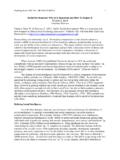Transcription of SLIC Superpixels - kev-smith.com
1 slic Superpixels ?Radhakrishna Achanta, Appu Shaji, Kevin Smith, Aurelien Lucchi,Pascal Fua, and Sabine S usstrunkSchool of Computer and Communication Sciences (IC) Ecole Polytechnique F edrale de Lausanne (EPFL) are becoming increasingly popular for use incomputer vision applications. However, there are few algorithms thatoutput a desired number of regular, compact Superpixels with a low com-putational overhead. We introduce a novel algorithm that clusters pixelsin the combined five-dimensional color and image plane space to effi-ciently generate compact, nearly uniform Superpixels .
2 The simplicity ofour approach makes it extremely easy to use a lone parameter specifiesthe number of Superpixels and the efficiency of the algorithm makes itvery practical. Experiments show that our approach produces superpix-els at a lower computational cost while achieving a segmentation qualityequal to or greater than four state-of-the-art methods, as measured byboundary recall and under-segmentation error. We also demonstrate thebenefits of our superpixel approach in contrast to existing methods fortwo tasks in which Superpixels have already been shown to increase per-formance over pixel-based IntroductionSuperpixels provide a convenient primitive from which to compute local im-age features.
3 They capture redundancy in the image [1] and greatly reduce thecomplexity of subsequent image processing tasks. They have proved increasinglyuseful for applications such as depth estimation [2], image segmentation [3, 4],skeletonization [5], body model estimation [6], and object localization [7].For Superpixels to be useful they must be fast, easy to use, and produce highquality segmentations. Unfortunately, most state-of-the-art superpixel methodsdo not meet all these requirements. As we will demonstrate, they often sufferfrom a high computational cost, poor quality segmentation, inconsistent size andshape, or contain multiple difficult-to-tune approach we advocate in this work, while strikingly simple, addressesthese issues and produces high quality, compact, nearly uniform Superpixels moreefficiently than state-of-the-art methods [8, 9, 5, 10].
4 The algorithm we propose,simple linear iterative clustering( slic ) performs a local clustering of pixelsin the 5-D space defined by theL,a,bvalues of the CIELAB color space and?Please cite this paper as: Radhakrishna Achanta, Appu Shaji, Kevin Smith, Aure-lien Lucchi, Pascal Fua, and Sabine S usstrunk, slic Superpixels , EPFL TechnicalReport 149300, June et segmented using our algorithm into Superpixels of (approximate) size 64,256, and 1024 pixels. The Superpixels are compact, uniform in size, and adhere well toregion ,ypixel coordinates. A novel distance measure enforces compactness andregularity in the superpixel shapes, and seamlessly accomodates grayscale aswell as color images.
5 slic is simple to implement and easily applied in practice the only parameter specifies the desired number of Superpixels . Experimentson the Berkeley benchmark dataset [11] show that slic is significantly moreefficient than competing methods, while producing segmentations of similar orbetter quality as measured by standard boundary recall and under-segmentationerror many vision tasks, compact and highly uniform Superpixels that respectimage boundaries, such as those generated by slic in Fig. 1, are desirable. Forinstance, graph-based models such as Conditional Random Fields (CRF) can seedramatic speed increases when switching from pixel-based graphs to superpix-els [3, 7], but loose or irregular Superpixels can degrade the performance.
6 Localfeatures such as SIFT extracted from the image at superpixel locations becomeless meaningful and discriminative if the Superpixels are loose or irregular, andlearning statistics over cliques of two or more Superpixels can be effect can be seen when we compare the performance of slic superpixelsto competing methods for two vision tasks: object class recognition and medicalimage segmentation. In both cases, our approach results in similar or greaterperformance at a lower computational cost in comparison to existing BackgroundIn this section, we briefly review existing image segmentation algorithms andfocus on their suitability for producing Superpixels .
7 Not all them were designedfor this specific purpose and may lack the ability to control the size, number, andcompactness of the segments, but we include them in our discussion broadly classify superpixel algorithms into graph-based and gradient-ascent-based. Our survey, summarized in Table 1, considers the quality of segmentation,and the ability of these algorithm to control the size and number of Technical Report 1493003 Table of state of the art superpixel segmentation thenumber of pixels in the image. GS04 and QS09 do not offer explicit control of thenumber of Superpixels . SL08 complexity given in this table does not take into accountthe complexity of the boundary map computation.
8 GS04 isO(N logN) complex but iscomparable in speed to slic for images less than million pixels while TP09 is alsoO(N) complex but is 10 times slower than slic for 481 321 pixel images. In the caseof QS09,dis a small constant (refer to [10] for details). The number of parameterslisted in the table is the minimum required for typical SL08WS91MS02 TP09 QS09 SLICS uperpixel no. (.)N logN N3/2N2logN N logN Graph-based algorithmsIn graph based algorithms, each pixel is treated as a node in a graph, andedge weight between two nodes are set proportional to the similarity betweenthe pixels.
9 Superpixel segments are extracted by effectively minimizing a costfunction defined on the Normalized cuts algorithm [9], recursively partitions a given graph usingcontour and texture cues, thereby globally minimizing a cost function defined onthe edges at the partition boundaries. It is the basis of the superpixel segmenta-tion scheme of [1] and [6] (NC05). NC05 has a complexity ofO(N32) [12], whereNis the number of pixels. There have been attempts to speed up the algorithm[13], but it remains computationally expensive for large images. The superpixelsfrom NC05 have been used in body model estimation [6] and skeletonization [5].
10 Fezenszwalb and Huttenlocher [8] (GS04) present another graph-based seg-mentation scheme that has been used to generate Superpixels . This algorithmperforms an agglomerative clustering of pixel nodes on a graph, such that eachsegment, or superpixel, is the shortest spanning tree of the constituent has been used for depth estimation [2]. It isO(NlogN) complex and isquite fast in practice as compared to NC05. However, unlike NC05, it does notoffer an explicit control on the number of Superpixels or their superpixel lattice is generated by [14] (SL08) by finding optimal vertical(horizontal) seams/paths that cut the image, within vertical (horizontal) stripsof pixels, using graph cuts on strips of the image.






